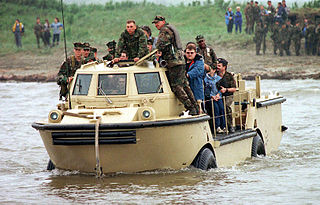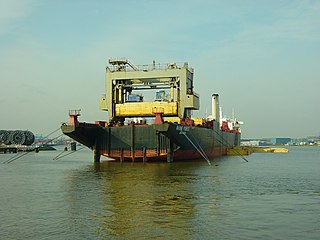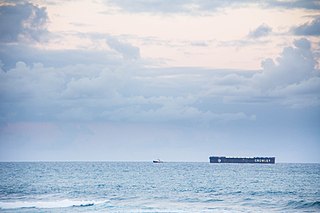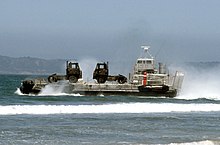The United States Navy, United States Coast Guard, and United States National Oceanic and Atmospheric Administration (NOAA) use a hull classification symbol to identify their ships by type and by individual ship within a type. The system is analogous to the pennant number system that the Royal Navy and other European and Commonwealth navies use.

A hovercraft, also known as an air-cushion vehicle or ACV, is an amphibious craft capable of travelling over land, water, mud, ice, and other surfaces.

An amphibious vehicle, is a vehicle that is a means of transport viable on land as well as on or under water. Amphibious vehicles include amphibious bicycles, ATVs, cars, buses, trucks, railway vehicles, combat vehicles and hovercraft.

Landing craft are small and medium seagoing watercraft, such as boats and barges, used to convey a landing force from the sea to the shore during an amphibious assault. The term excludes landing ships, which are larger. Production of landing craft peaked during World War II, with a significant number of different designs produced in large quantities by the United Kingdom and United States.

The Landing Craft Air Cushion (LCAC) is a class of air-cushion vehicle (hovercraft) used as landing craft by the United States Navy's Assault Craft Units and the Japan Maritime Self-Defense Force (JMSDF). They transport weapons systems, equipment, cargo and personnel of the assault elements of the Marine Air/Ground Task Force both from ship to shore and across the beach. It is to be replaced by the Ship-to-Shore Connector (SSC).
A lighter is a type of flat-bottomed barge used to transfer goods and passengers to and from moored ships. Lighters were traditionally unpowered and were moved and steered using long oars called "sweeps" and the motive power of water currents. They were operated by skilled workers called lightermen and were a characteristic sight in London's docks until about the 1960s, when technological changes made this form of lightering largely redundant. Unpowered lighters continue to be moved by powered tugs, however, and lighters may also now themselves be powered. The term is also used in the Lighter Aboard Ship (LASH) system.

The Patrol Air Cushion Vehicle (PACV), also known as the Air Cushion Vehicle (ACV) in Army and Coast Guard service, was a United States Navy and Army hovercraft used as a patrol boat in marshy and riverine areas during the Vietnam War between 1966 and 1970. Six hovercraft were built, three for the Army and three for the Navy.
A Surface Effect Ship (SES) or Sidewall Hovercraft is a watercraft that has both an air cushion, like a hovercraft, and twin hulls, like a catamaran. When the air cushion is in use, a small portion of the twin hulls remains in the water. When the air cushion is turned off, the full weight of the vessel is supported by the buoyancy of the twin hulls.

The lighter aboard ship (LASH) system refers to the practice of loading barges (lighters) aboard a bigger vessel for transport. It was developed in response to a need to transport lighters, a type of unpowered barge, between inland waterways separated by open seas. Lighters are typically towed or pushed around harbors, canals or rivers and cannot be relocated under their own power. The carrier ships are known variously as LASH carriers, barge carriers, kangaroo ships or lighter transport ships.

Crowley Maritime Corporation, is based in Jacksonville, Florida. Founded in 1892, Crowley is primarily a family- and employee-owned vessel management, owner, and supply chain logistics services company, providing services globally. As of July 2016, Crowley was ranked as the 13th largest private company in Florida, employing approximately 5,300 people worldwide with revenues of $2.2 billion. It provides its services using a fleet of more than 300 vessels, consisting of RO-RO vessels, LO-LO vessels, tankers, Articulated Tug-Barges (ATBs), tugs and barges. Crowley's land-based facilities and equipment include terminals, warehouses, tank farms, and specialized vehicles.

LARC-V, is an aluminium-hulled amphibious cargo vehicle capable of transporting 5 tons. It was developed in the United States during the 1950s, and is used in a variety of auxiliary roles to this day.

LARC-XV, introduced in 1960, is an aluminium hulled amphibious cargo vehicle. It measures 45 by 15 feet and is powered by 2-300 hp engines.

The LARC-LX, or as it was originally designated BARC is a welded steel-hulled amphibious cargo vehicle.
Worldwide Aeros Corp is an American manufacturer of airships based in Montebello, California. It was founded in 1993 by the current CEO and Chief Engineer, Igor Pasternak who was born in Soviet Kazakhstan, raised in Soviet Ukraine, and moved to the U.S. after the Soviet collapse to build airships there. It currently employs more than 100 workers.

The Type 722 II class LCAC with NATO reporting name Jinsha II class LCAC is a medium size air-cushioned landing craft (hovercraft) operated by the People's Liberation Army Navy of China. It is frequently but erroneously referred by many as Dagu class, its predecessor, due to misspelling and lack of information in the 1970s, when these projects first appeared. There are also other names for this class, mostly resulting from different transliterations.

The British Hovercraft Corporation AP1-88 is a medium-size hovercraft. In a civil configuration, the hovercraft can seat a maximum of 101 passengers, while as a troop carrier, it can transport up to 90 troops. When operated as a military logistics vehicle, the AP1-88 can carry a pair of Land Rovers, a Bv202 tracked vehicle and trailer unit or up to roughly 10 tons (10,000 kg) of cargo.

Yulius Fuchik was a Soviet and later Ukrainian barge carrier. Derivatives of the Seabee system, she and her sister ship, Tibor Szamueli, were built in the late 1970s by the Finnish state-owned shipbuilder Valmet in Vuosaari shipyard. As the demand for lighter transport fell in the 1990s, she was sold and eventually broken up in Alang in 2003.

SB Centaur is a wooden Thames sailing barge, built in Harwich, Essex, England in 1895. She was used to carry various cargoes, mainly grain, for the next 60 years. During the First World War she carried food and coal to the French Channel ports. During the Second World War Centaur was damaged when sailing to assist with the Dunkirk Evacuation. She did war work for the duration of the conflict.













